
Compartment 4 lies south of the A339 Newbury-Basingstoke Road, stretching in a linear form from west to east and divided into 3 subcompartments. The habitats are made up of wooded wet gullies, lowland heathland and semi-natural woodland with a small amount of pine plantation. There are access tracks to a string of properties, and the compartment is dissected again by Bishop's Green Road. Compartments 4A (Clarke's Gully) and 4B (Bishop's Green Heath) are SSSI. The area is not stock fenced and not grazed.
General description and evaluation of ecology
This compartment contains lowland dry and wet heathland communities consisting predominantly of mature heath with scattered scrub and gorse, and acid grassland (including an abundance of purple moor grass). The heathland attracts wildlife including nightjars and adders.
The two streams along the bottom of the steep sided wet woodland gullies are continuations of the Aldernbridge and Ballshill/Handpost Gullies, running from the north side of and under the A339. These gullies host ancient woodlands and are similarly important for a species-rich ground flora including bryophytes with moschatel, bluebells and yellow archangel. This may be a remnant dormouse habitat but no recent (2013) evidence has been found.
BAP habitats
- Lowland heathland (4B)
- Wet woodland (4A)
Higher Level Stewardship
Options exist for subcompartment 4B.
Overall management objectives
Where mature or relict lowland heathland exists the opportunities to maintain or expand should be considered, while retaining a quantity of scrub and mature trees. A diverse heather structure is to be maintained by mowing and scraping. Elsewhere bramble, gorse and scrub can develop if it remains within limits. Long term plans should look at introducing the woodland into the English Woodland Grant Scheme.
The wet woodlands will be minimally managed with selective thinning of sycamore and possible coppicing of alder and hazel along with any work arising from an annual tree safety inspection. The remaining secondary woodland should be left largely as non intervention with possible clearance of rides and areas where relict heath exisits.
Subcompartment 4A (4.6 ha) Clarke's Gully
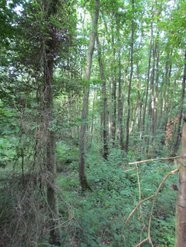
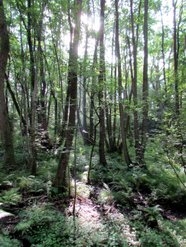
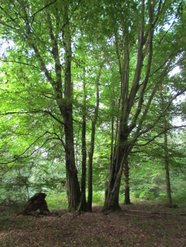
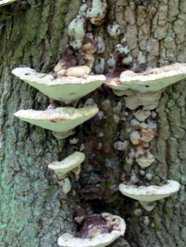
This area contains the two southern extensions of Aldernbridge and Ballshill Gullies which flow from the main common and under the A339 into Clarke's Gully. The wet ground at the base of the slopes down to the streams contains mature coppice alder and an associated species-rich ground flora, although locally dominated by nettles. The drier ground between the gullies contains a mixed broadleaf woodland with oak, ash, birch, sycamore and hornbeam, and some small neglected hazel coppice. There are also elements of wood pasture and some fine mature trees including oak, hornbeam and ash. A dense thicket mainly of birch occurs alongside the A339 and there are some prominent woodbanks. The south facing slope and adjacent field to the south (not owned by WBC and not part of the common) down to the River Enborne makes for an interesting woodland/field edge and has attracted barn owls in the past. Subcompartment 4A is to be retained as woodland.
| Objective | Area | Method | Comment |
|---|---|---|---|
| 4A.1) Create a more diverse structured alder woodland. | The two wet gullies dominated by alder. | Explore feasibility of selective coppicing on minimal scale of alder in gullies. Create lying deadwood and a ‘natural’ feel by felling and leaving trees intact but remove brash or consider extraction. Stack brash where suitable and leave stumps to regenerate. Leave standing deadwood where safe. Undertake trial initially leaving one pole per stool uncut, monitor regeneration and coppicing on long term cycle. Essentially manage as high forest and re-create natural looking glades. | Further management to be identified in Alder Gully Management Plan in long term projects. |
| 4A.2) Retain woodland screen along A339. | Northern edge of subcompartment. | Non-intervention. | |
| 4A.3) Create a more diverse structured oak woodland. | Mixed broadleaf woodland between the two gullies. | Selective felling of birch and sycamore to favour oak. Allow either some stumps to regrow or treat with chemical. Ring-bark to create standing deadwood where possible, particularly sycamore. Protect young saplings and cut stumps from deer. Coppice neglected hazel stands where appropriate. | Protect regeneration particularly of mature hornbeams along wood bank. (Advice from Heritage Mangement Plan). |
Subcompartment 4B (9.2 ha) Bishop's Green Heath
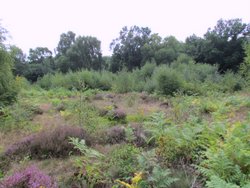
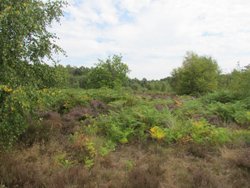
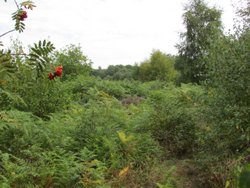
Subcompartment 4B sits on a plateau and is a mix of habitats including heathland with birch and gorse scrub, secondary woodland and areas dominated by bracken although these have been controlled in the past by spraying. This heath is different from those on the main common with an abundance of purple moor grass, and the absence of cattle or pony grazing. The area is fragmented by several access tracks to properties along the southern edge. Nightjar and adders have been recorded here and a small wet mire contains mosses (Sphagnum spp.). Around the margins of the plateau is some older oak woodland with a few damp hollows on spring sites. The stream at the western edge of this subcompartment marks the boundary with 4A in which more of the alder woodland occurs. A path runing parallel and next to the A339 is bordered by mature and degenerate gorse.
| Objective | Area | Method | Comment |
|---|---|---|---|
4B.1) Maintain existing heathland and acid grassland mosaic. Continue diversifying the structure.
HLS objectives |
Where heath and semi-natural grassland occurs in all of 4B. | Mow heath in strips over a 25 year rotation. (Up to 5% of heath area each year, preferably in short, thin, sinuous shapes. Collect and remove cuttings and deposit on site in suitable woodland edge. Create small scrapes (1% of heath) for bare ground/gravel and pioneer heather regeneration each year. Control bracken, willow, birch, gorse scrub and brambles by mowing or cutting, using chemicals if required. Where Bracken has dominated, the litter can be scraped to encourage new heather growth. Maintain patches of bramble and gorse on the grassland for invertebrates, and nesting cover. Reduce areas of degenerate gorse to minimise fire hazard. Remove birch and willow scrub (especially from mire) and treat stumps where it starts to invade dry heath. Maintain small clumps of birch and single mature trees in open heath for cover and perches. Also, maintain a thick boundary of scrub where heath meets the woodland and cut small sections of this each year. |
Nightjar nesting area. |
| 4B.2) Create a more diverse structured alder woodland (to be considered alongside similar objective in 4A). | The gully edge dominated by alder. | Explore feasibility of selective coppicing on minimal scale of alder in gullies. Create lying deadwood and a ‘natural’ feel by felling and leaving trees intact but remove brash or consider extraction. Stack brash where suitable and leave stumps to regenerate. Leave standing deadwood where safe. Undertake trial initially leaving one pole per stool uncut, monitor regeneration and coppicing on long term cycle. (Or manage as high forest.) Retain root plates where trees have fallen. |
Further management to be identified in Alder Gully management plan. |
| 4B.3) Expand area of dry heath where remnant heather exists under secondary woodland. | Around edges of existing heath. | Scallop woodland edge boundary in small, crescent shaped arcs to increase heathland/woodland boundary and either treat with chemical where remnant heath exists or allow to re-grow to create a thick scrub layer. | The woodland screen adjacent to properties and the A339 will be retained. |
| 4B.4) Create a more diverse structured oak woodland (to be considered alongside similar objective in 4A). | Mixed broadleaf woodland between the two gullies. | Selective felling of birch and sycamore to favour oak. Allow either some stumps to re-grow or treat with chemical. Ring-bark to create standing deadwood where possible. Protect young saplings and cut stumps from deer. Coppice neglected hazel stands and ash where appropriate. Retain root plates where trees have fallen. |
Subcompartment 4C (7.2 ha)
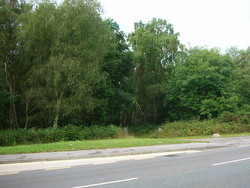
Subcompartment 4C is fragmented by properties and access tracks on a plateau predominantly consisting of birch woodland with some older, oak and hazel, alder coppice near the plateau edge and rowan, holly, ash, alder buckthorn and yew. Small mires with Sphagnum spp. mosses occur on lower ground and there are fragments of dry heathland, mainly alongside paths. There is a small, rich wildflower meadow (most likely sown) alongside the A339 near the entrance to the business park containing many oxeye daisies and bird's-foot trefoil. The western end is very disjointed around houses. A pine plantation and some Rhododendron ponticum are also present.
| Objective | Area | Method | Comment |
|---|---|---|---|
| 4C.1) Maintain species diversity and structured woodland. | All of 4C. | Maintain as high forest and open small scale glades in secondary birch woodland as well as areas of hazel and alder. Look at feasibility of opening up paths and access routes to create rides. Allow stumps to re-grow and stack logs and brash. Remove or control invasive species like Rhododendron ponticum, sycamore, bamboo and Himalayan balsam. Retain pine woodland for diversity. | Maintain roadside screen. |
| 4C.2) Open up mire areas. | Where mires with sphagnum moss occur. | Keep mires free from scrub and treat stumps. Coppice neglected hazel and alder where appropriate. | Liaise with local residents before works. |